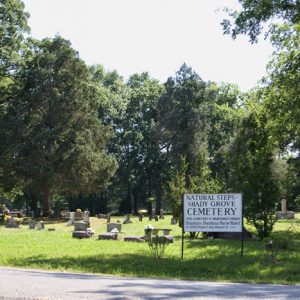calsfoundation@cals.org
Natural Steps (Pulaski County)
Natural Steps is an unincorporated community located on Highway 300 between Lake Maumelle and the Arkansas River in Pulaski County. It takes its name from a unique sandstone formation in the shape of parallel stair steps.
A 1932 archaeological investigation into the Natural Steps area conducted by staff at the University of Arkansas (UA) in Fayetteville (Washington County) uncovered fifty-seven burials, as well as pottery from both the Quapaw and Caddo tribes. An exact sequence of Native American habitation of the area, however, remains unknown. A Spanish land grant conveyed land at Natural Steps to Eli Stidwell. Another early white settler was John Standlee, who was in the area from 1778 to 1780. In the 1810s, merchant John Taylor purchased forty acres in the area for his son, Creed, who settled in the area with his sister’s husband and children in 1819, though a competing land claim later forced them from their home. Creed Taylor’s brother Sam established a sawmill with their brother-in-law, which proved profitable as Little Rock (Pulaski County) was growing at the time. With the advent of steamboats on the Arkansas River, Natural Steps soon developed into a port for passengers and cargo. However, survey maps show no actual town at Natural Steps before the Civil War. According to legend, bushwhackers—and later the Ku Klux Klan—used Natural Steps as a rendezvous point.
Bart Moreland and his family moved to the area in 1866; he later opened a general store. Other families soon began to settle around Natural Steps. A small engagement in the Brooks-Baxter War took place on the river near Natural Steps on May 8, 1874, when the steamboat Hallie was deployed to intercept a flatboat reportedly coming down the river carrying guns for the forces of Joseph Brooks. Brooks loyalists along the bank were successful in disabling the steamboat.
A post office was established for the community on September 6, 1880, though it lasted only until October 3, 1881. The community and its sandstone step formation soon became a popular picnic destination, and a Methodist church was established in the mid-1880s. A school was operated in this building until the late 1920s. In 1898, the Memphis and Choctaw Railroad ran through the southern edge of the community, complete with a train station. A grocery store, cotton gin, and blacksmith shop were established in the town, which received a post office again on March 15, 1901, though it was discontinued on August 31, 1925. A Baptist church was organized in 1912, but the town never grew, and the railroad ceased serving the area.
Historian J. H. Atkinson wrote of a May 8, 1960, trip to Natural Steps, “The cemetery, the church, the overgrown river bank, and the [E. L.] Kinkead house are about all that is left as evidence of what was once the community of Natural Steps.” However, farming still continues in the area, and the creation of nearby Pinnacle Mountain State Park in the mid-1970s, as well as the construction of the Ouachita National Recreation Trail, which runs just west of Natural Steps, now bring a new generation of hikers and picnickers through the area.
For additional information:
Atkinson, J. H. “An Excursion to Natural Steps.” Pulaski County Historical Review 8 (September 1960): 39–40.
Henker, Fred O. “Natural Steps, Arkansas.” Pulaski County Historical Review 47 (Spring 1999): 12–19.
Owen, David Dale. Second Report of a Geological Reconnaissance of the Middle and Southern Counties of Arkansas: Made during the Years 1859 and 1860. Philadelphia: C. Sherman, 1860.
Staff of the CALS Encyclopedia of Arkansas
 Moreland House
Moreland House  Natural Steps
Natural Steps  Natural Steps
Natural Steps  Pulaski County Map
Pulaski County Map  Shady Grove Cemetery
Shady Grove Cemetery 



Comments
No comments on this entry yet.